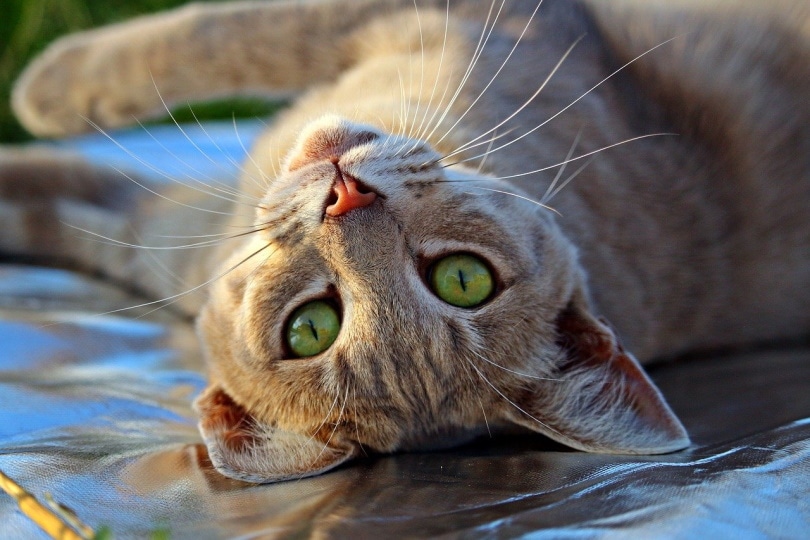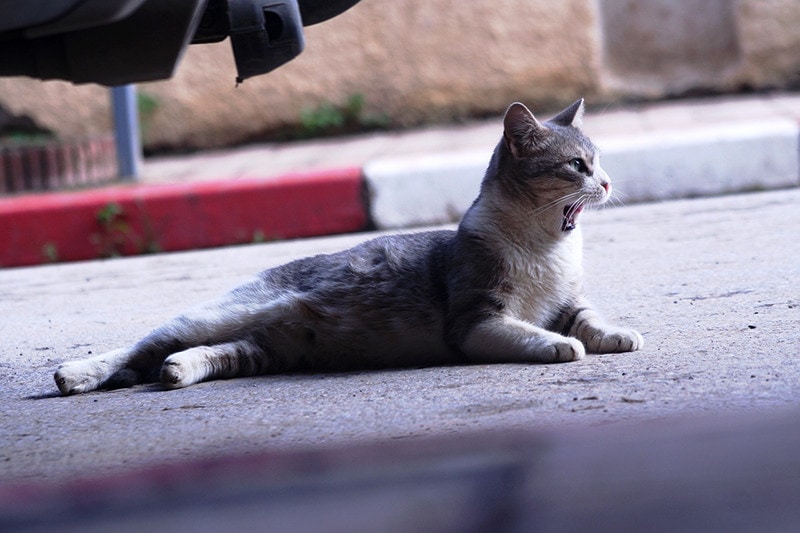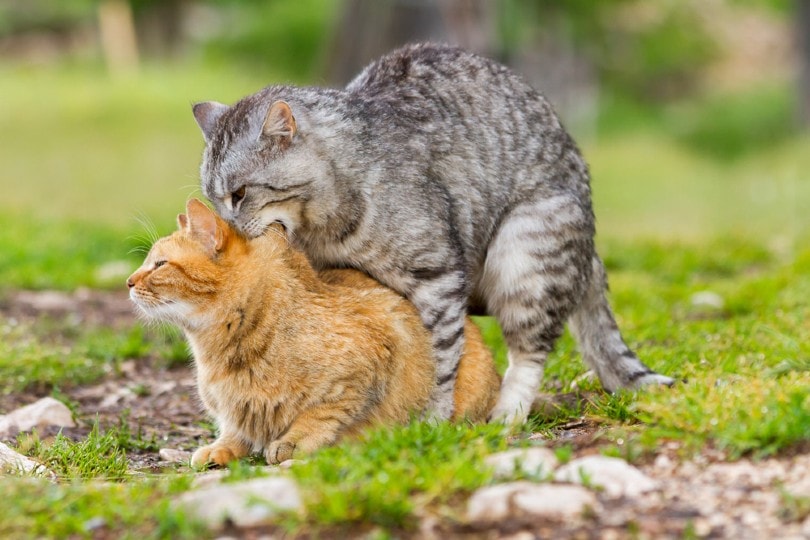
Sexual maturity in cats isn’t the first thing most people think about when they take in a cat under their care. However, understanding this growth stage in cats is critical as it enables you to know how to deal with your kitty when it reaches sexual maturity.
So, at what age do cats reach their sexual maturity?
Male cats can become sexually active between 4–6 months old, usually closer to 6 months old. However, they usually cannot get a female cat pregnant until around 6–12 months of age. On the other hand, female cats become sexually mature as early as four months of age.
With that being said, below is an all-inclusive guide that explains everything you need to know about sexual maturity in cats.
At What Age Do Male Cats Become Sexually Mature?

As was mentioned above, male kittens become sexually mature around 4–6 months old but are unable to impregnate a female cat until between 6–12 months of age.
When a male kitten is about to be born, its body experiences a surge in testosterone. However, the Leydig cells (which are responsible for producing testosterone) remain inactive until the kitten is around 3 months old. At this time, the male kitten will have had enough testosterone to initiate the growth of penile spines (yes, male cats have barbed penises), which reach full size at about 6–7 months of age.
At around 5 months of age, the male kitten’s testes are mature enough for early spermatogenesis. However, it usually takes an additional 1–2 months before sperm can be found in its seminal tubules.
How Do I Know If My Male Cat Is Sexually Mature?
Let’s look at the physical and behavioral signs indicating your male feline friend is sexually active.
1. Easily Visible Testicles
One sign of sexual maturity is visibility of his testicles once they they have fully developed. Typically, a male cat’s testicles begin developing around 2 months of age. However, they will be fully developed and easily visible later on. But keep in mind that not all male kitties’ testicles descend when they are sexually mature.
2. Strong and Unpleasant Urine Odor
As your male cat becomes sexually active, you’ll notice that its urine has a strong and unpleasant odor. This smell is attributed to high levels of hormones such as testosterone.
3. Urine Marking (Spraying)

Usually, as your male cat becomes sexually mature, it becomes more territorial. This means it will feel the need to mark its territory, and one way it will do so is by urine marking (spraying). So, your cat will spray its distinctively malodorous urine around its habitat, namely your home or yard.
4. Aggressive Personality
Unfortunately, it’s not only humans who experience the “moody teenager” phase. As cats, especially male ones, become sexually mature, their personality begins to change. So, your male kitty may begin being more aggressive towards you, other people in your home, and even other pets (if you have any).
5. Mate-Seeking
Your male cat will be more dedicated to finding a mate as it becomes sexually active. You’ll notice your cat starts developing habits meant to charm female cats, such as frequent yowling and prowling. You’ll also notice that your cat will begin sneaking out of the house regularly. What’s more, it may begin fighting other cats outside for female companions.
At What Age Do Female Cats Become Sexually Mature?
Usually, female cats become sexually mature at around 4–6 months old. Once they become sexually mature, they begin going through estrous cycles, better known as heat cycles.
How Often Does a Female Cat Go “Into Heat?”

Typically, female kitties are seasonally polyestrous, meaning they have several estrous/heat cycles throughout the breeding season. Normally, a cat’s breeding season varies with environmental and geographical factors, such as the number of daylight hours and the temperature.
For instance, cats in the Northern Hemisphere go through their estrous cycle from January until late in the fall season. On the other hand, cats in tropical regions or who live mainly indoors go through their estrous cycle throughout the year due to the increased number of daylight hours.
How Long Does an Estrous Cycle Last?
Typically, a female cat cycle can last anywhere between 1–21 days; however, the average length is about seven days. If the cat doesn’t mate during its cycle, she will go “out of heat” for about 2–19 days. So, a complete female cat’s estrous cycle can last between 1–6 weeks, with the average length being approximately 3 weeks.
What Are the Signs That My Female Cat Is Sexually Active?
Here are the main tell-tale signs that a female kitty is sexually mature.
1. Cat Calling

When your female cat is sexually active, you’ll notice that it will begin to howl for long periods. Sometimes, its meowing could sound as if it is in pain. Usually, female cats make these vocalizations to attract male companions.
2. Increased Affection
Another tell-tale sign that your cat “is in heat” is increased affection. Even normally affectionate cats will begin to display increased signs of affection and will start to pay more attention to other pets, people, and even furniture.
If your female cat is rubbing its head and bottom against furniture or people more frequently, weaving between its legs, and rolling on the floor more often, it may very well mean that she’s “in heat.”
3. Assuming the Mating Position More Often
When your cat is sexually active, you’ll notice that she assumes the mating position (lordosis) more often, especially when she is pet. Her head will drop, she will lay the front half of her body lower to the floor, and she will raise the back side of her body with her tail pushed aside.
4. Strong and Unpleasant Odor in Its Urine

Like male cats, sexually mature female kitties’ urine also has a strong and unpleasant smell. This odor is attributed to the increased levels of estrogen.
5. Urine Marking (Spraying)
Similar to male kitties, female cats also spray their urine on vertical surfaces, but for a different reason. Usually, they do so to attract male companions.
6. Excessive Licking
When your female cat is sexually active, as a self-grooming technique, she will begin to lick her genital area, which may swell.
7. Mate Seeking

You may also notice your cat loitering outside for more extended periods if you let her out, or she will try to escape if she’s indoors only in order to search for a male partner.
Neutering/Spaying In Cats
Veterinarians recommend spaying or neutering your feline companion unless you plan to breed your cat responsibly. So, what exactly is neutering?
Neutering, scientifically known as orchidectomy in male cats, is a surgical procedure that involves removal of the testicles, once sexually mature.
Spaying in female cats is also a surgical procedure that involves removal of the ovaries and/or uterus, preventing future estrous cycles and reproduction. Typically, there are two types of spaying; ovariectomy, which involves taking out a cat’s ovaries, and ovariohysterectomy, which is the removal of a cat’s ovaries and uterus.
There are many benefits of neutering or spaying a cat.
Conclusion
Understanding sexual maturity in cats is important if you are a cat owner or an aspiring one. While spaying or neutering is highly advisable when it comes to controlling a sexually active cat, it’s recommendable to consult a veterinarian to understand fully everything there is to know about these procedures.
Featured Image Credit: Firn, Shutterstock








